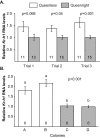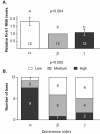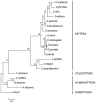The transcription factor Krüppel homolog 1 is linked to hormone mediated social organization in bees
- PMID: 20429952
- PMCID: PMC2876159
- DOI: 10.1186/1471-2148-10-120
The transcription factor Krüppel homolog 1 is linked to hormone mediated social organization in bees
Abstract
Background: Regulation of worker behavior by dominant queens or workers is a hallmark of insect societies, but the underlying molecular mechanisms and their evolutionary conservation are not well understood. Honey bee and bumble bee colonies consist of a single reproductive queen and facultatively sterile workers. The queens' influences on the workers are mediated largely via inhibition of juvenile hormone titers, which affect division of labor in honey bees and worker reproduction in bumble bees. Studies in honey bees identified a transcription factor, Krüppel-homolog 1 (Kr-h1), whose expression in worker brains is significantly downregulated in the presence of a queen or queen pheromone and higher in forager bees, making this gene an ideal candidate for examining the evolutionary conservation of socially regulated pathways in Hymenoptera.
Results: In contrast to honey bees, bumble bees foragers do not have higher Kr-h1 levels relative to nurses: in one of three colonies levels were similar in nurses and foragers, and in two colonies levels were higher in nurses. Similarly to honey bees, brain Kr-h1 levels were significantly downregulated in the presence versus absence of a queen. Furthermore, in small queenless groups, Kr-h1 levels were downregulated in subordinate workers with undeveloped ovaries relative to dominant individuals with active ovaries. Brain Kr-h1 levels were upregulated by juvenile hormone treatment relative to a vehicle control. Finally, phylogenetic analysis indicates that KR-H1 orthologs are presence across insect orders. Though this protein is highly conserved between honey bees and bumble bees, there are significant differences between orthologs of insects from different orders.
Conclusions: Our results suggest that Kr-h1 is associated with juvenile hormone mediated regulation of reproduction in bumble bees. The expression of this transcription factor is inhibited by the queen and associated with endocrine mediated regulation of social organization in two species of bees. Thus, KR-H1 may transcriptionally regulate a conserved genetic module that is part of a pathway that has been co-opted to function in social behavior, and adjusts the behavior of workers to their social environmental context.
Figures




Similar articles
-
Exploring the role of juvenile hormone and vitellogenin in reproduction and social behavior in bumble bees.BMC Evol Biol. 2014 Mar 11;14(1):45. doi: 10.1186/1471-2148-14-45. BMC Evol Biol. 2014. PMID: 24618396 Free PMC article.
-
Endocrine modulation of a pheromone-responsive gene in the honey bee brain.J Comp Physiol A Neuroethol Sens Neural Behav Physiol. 2007 Apr;193(4):461-70. doi: 10.1007/s00359-006-0202-x. Epub 2006 Dec 28. J Comp Physiol A Neuroethol Sens Neural Behav Physiol. 2007. PMID: 17192826
-
Developmental exposure to hormone-mimicking insect growth disruptors alters expression of endocrine-related genes in worker honey bee (Hymenoptera: Apidae) brains and hypopharyngeal glands.J Econ Entomol. 2024 Apr 12;117(2):377-387. doi: 10.1093/jee/toae006. J Econ Entomol. 2024. PMID: 38289584
-
Integration of information from multiple sources drives and maintains the division of labor in bumble bee colonies.Curr Opin Insect Sci. 2023 Dec;60:101115. doi: 10.1016/j.cois.2023.101115. Epub 2023 Sep 12. Curr Opin Insect Sci. 2023. PMID: 37704097 Review.
-
Juvenile hormone, behavioral maturation, and brain structure in the honey bee.Dev Neurosci. 1996;18(1-2):102-14. doi: 10.1159/000111474. Dev Neurosci. 1996. PMID: 8840089 Review.
Cited by
-
Krüppel-homologue 1 Mediates Hormonally Regulated Dominance Rank in a Social Bee.Biology (Basel). 2021 Nov 15;10(11):1188. doi: 10.3390/biology10111188. Biology (Basel). 2021. PMID: 34827180 Free PMC article.
-
Worker Reproduction and Caste Polymorphism Impact Genome Evolution and Social Genes Across the Ants.Genome Biol Evol. 2023 Jun 1;15(6):evad095. doi: 10.1093/gbe/evad095. Genome Biol Evol. 2023. PMID: 37243539 Free PMC article.
-
Behavioral plasticity in honey bees is associated with differences in brain microRNA transcriptome.Genes Brain Behav. 2012 Aug;11(6):660-70. doi: 10.1111/j.1601-183X.2012.00782.x. Epub 2012 Apr 6. Genes Brain Behav. 2012. PMID: 22409512 Free PMC article.
-
Diversity of Insect Sesquiterpenoid Regulation.Front Genet. 2020 Sep 10;11:1027. doi: 10.3389/fgene.2020.01027. eCollection 2020. Front Genet. 2020. PMID: 33133135 Free PMC article. Review.
-
Exploring the role of juvenile hormone and vitellogenin in reproduction and social behavior in bumble bees.BMC Evol Biol. 2014 Mar 11;14(1):45. doi: 10.1186/1471-2148-14-45. BMC Evol Biol. 2014. PMID: 24618396 Free PMC article.
References
-
- Wilson EO. The Insect Societies. Cambridge, MA: The Belkap Press of Harvard University Press; 1971.
-
- Michener CD. The Social Behavior of Bees. Cambridge: Harvard University Press; 1974.
-
- Gadagkar R. In: Orientation and Communication in Arthropods. Lehrer M, editor. Basel/Switzerland: Birkhauser Verlag; 1997. The evolution of communication and the communication of evolution: The case of the honey bee queen pheromone; pp. 375–395.
-
- Keller L, Nonacs P. The role of queen pheromones in social insects: queen control or queen signal? Anim Beh. 1993;45:787–794. doi: 10.1006/anbe.1993.1092. - DOI
Publication types
MeSH terms
Substances
Associated data
- Actions
LinkOut - more resources
Full Text Sources

